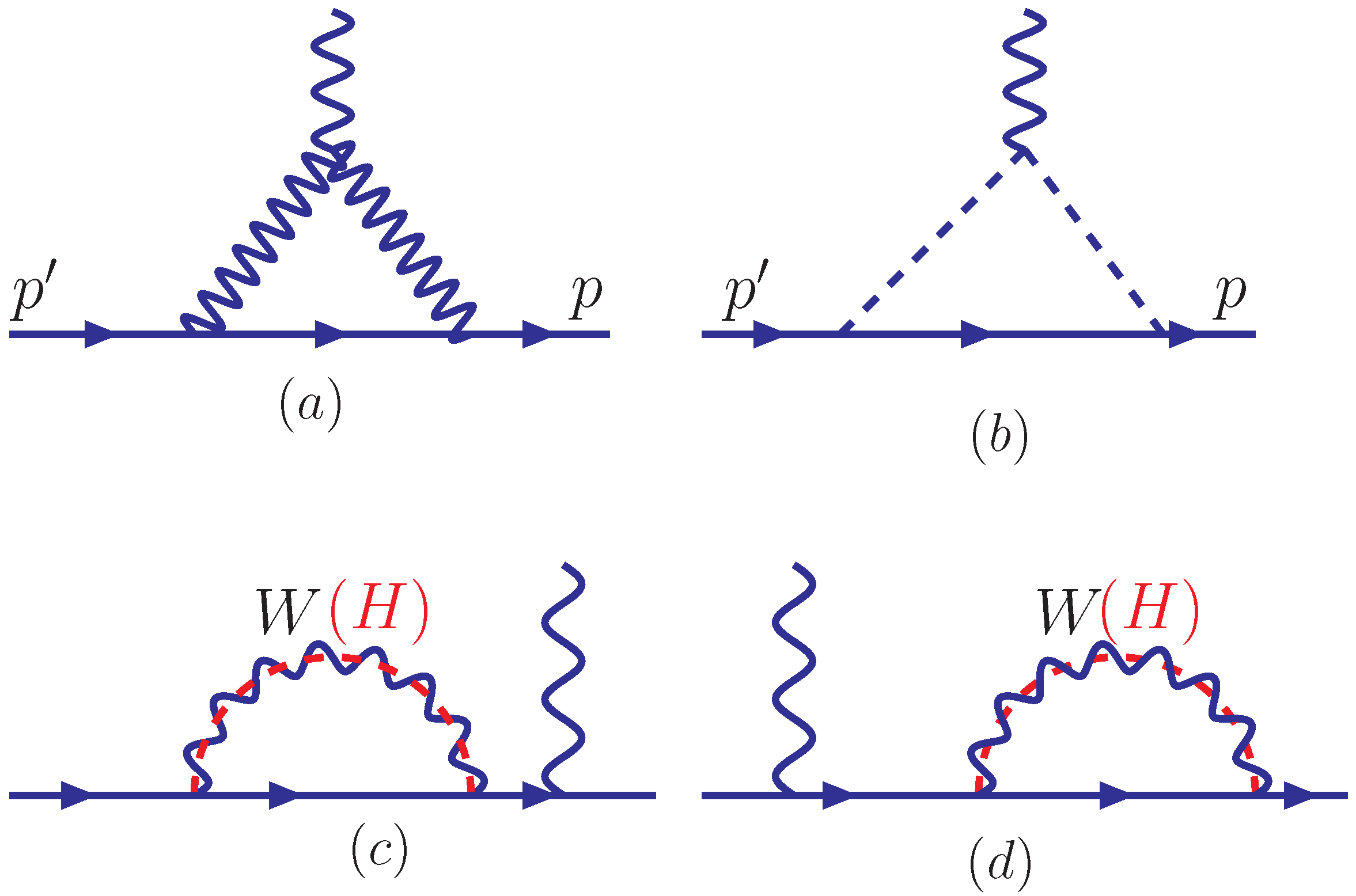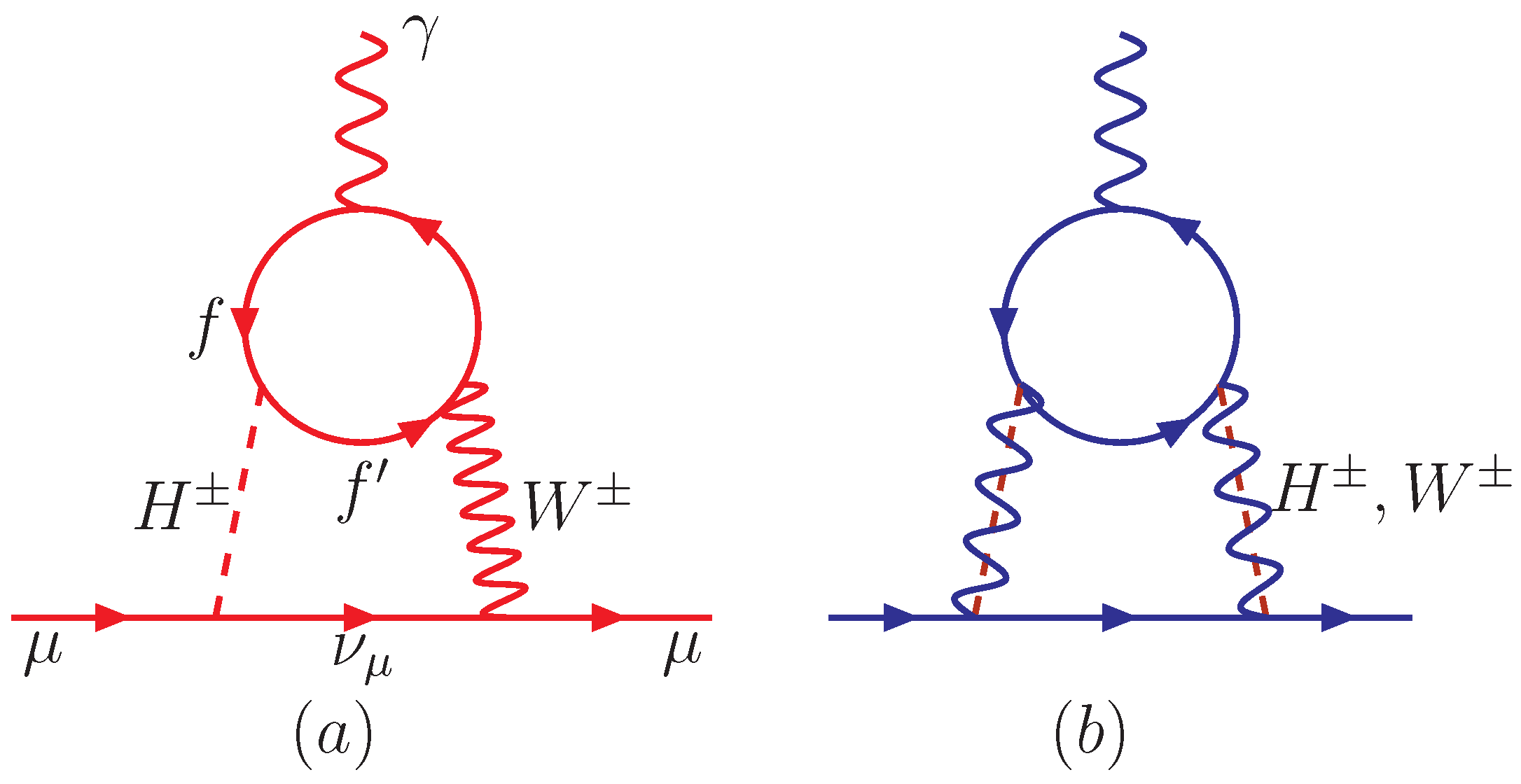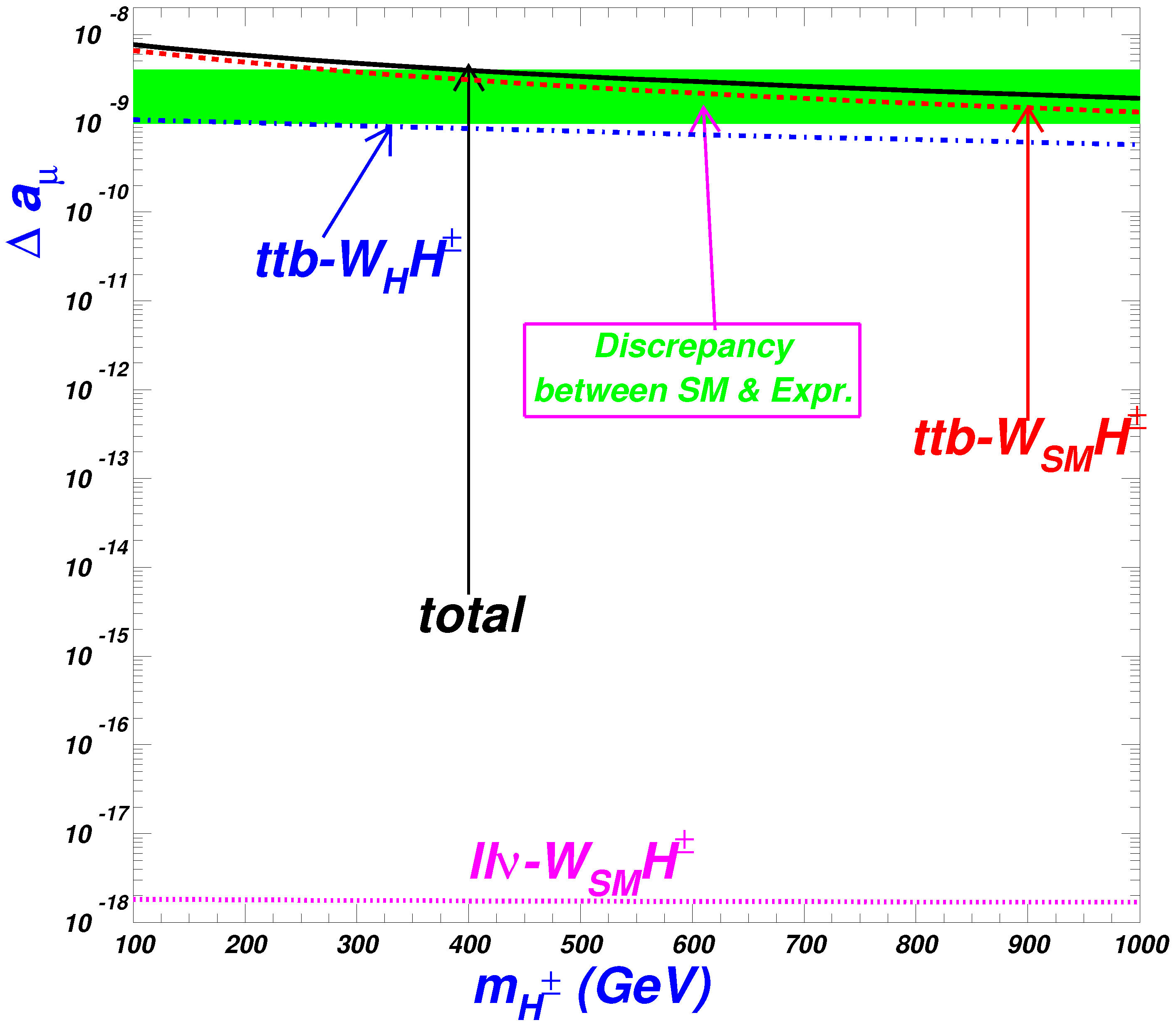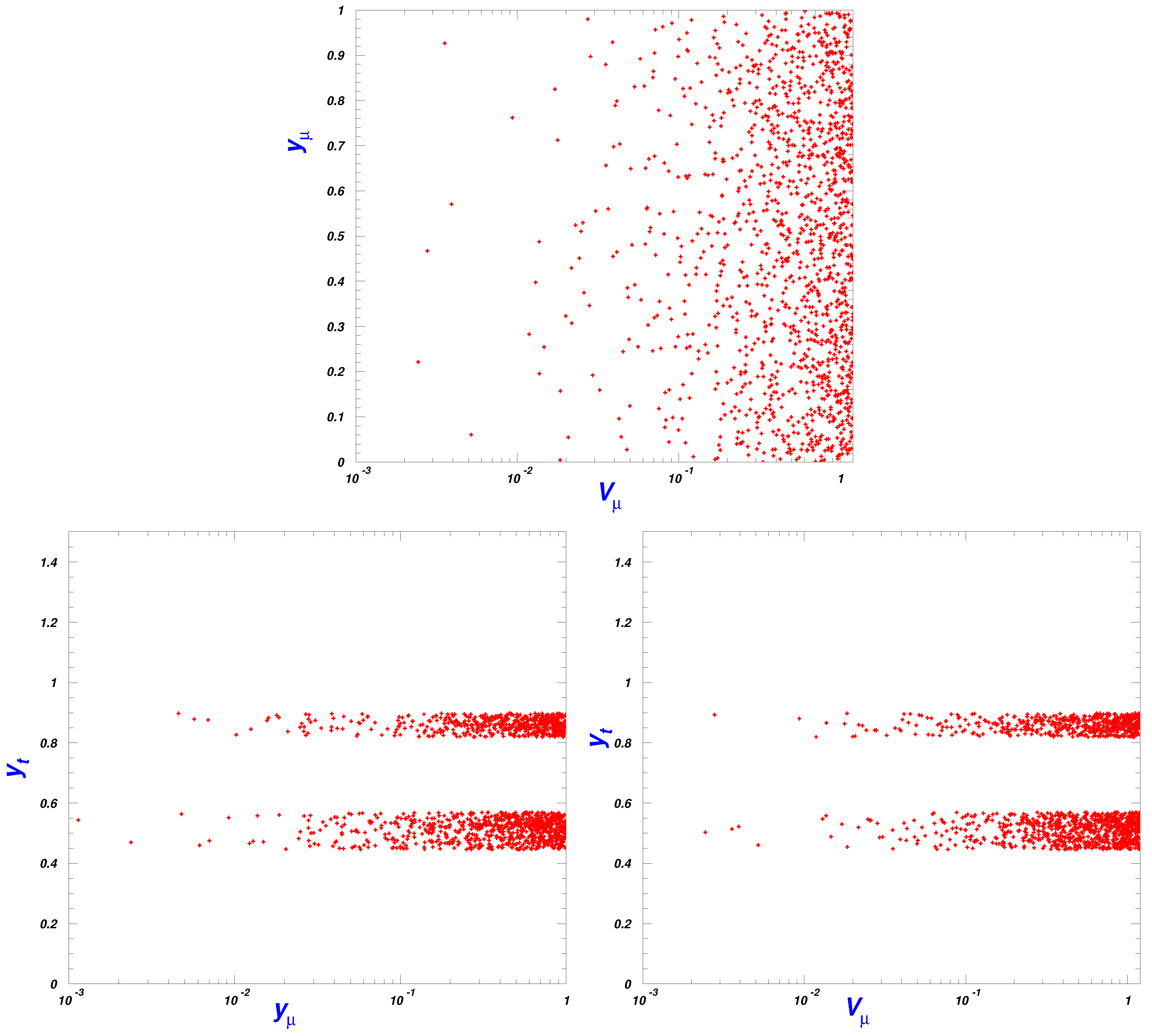The Contribution of Charged Bosons with Right-Handed Neutrinos to the Muon g − 2 Anomaly in the Twin Higgs Models
Abstract
:1. Introduction
2. The TH Models and the Relevant Couplings
2.1. The Charged Higgses and the Yukawa Couplings to the Third Generation in Twin Higgs Models
2.2. Flavor-Changing Couplings of Leptons in TH Models
3. The Rough Ranges of the Relevant Parameters in TH Models
- (1)
- The first constraint comes from the signal data of the 125 GeV Higgs, which is important, since the couplings of the SM-like Higgs with the fermions and the bosons in TH models can deviate from the SM largely and the production and decay modes of the SM-like Higgs may be modified severely. In the paper, we will perform the calculation of for the signal strengths of the 125 GeV Higgs, which will be shown in Section 5 and Section 6.
- (2)
- The constraints on parameter f come from the joint effects of the Z-pole precision measurements, the low-energy neutral current process, and the high-energy precision measurements off the Z-pole indirectly, and according to all these data, f should be larger than 500–600 GeV [74]. On the other hand, to control in a mild fine tuning, f should not be too large, since the fine tuning is more severe for large f. The constraints for f can also come from the flavor-changing decay : With the experimental constraints, [75,76], , the flavor-changing decay will give TeV.So after we take the above constraints from the electroweak precision measurements and the LHC data into account, we can assume that GeV. In our numerical evaluations, however, we have not taken f as a free parameter. Instead, we assume the characteristic mass and coupling of the composite resonances is set by m and g, respectively, which are related by the symmetry-breaking order parameter, f, as .
- (3)
- In the present experiments, has been constrained stringently [77,78,79]. The ATLAS experiment has presented the first search for dilepton resonances based on the full Run 2 data-set [77,79] and set limits on the production cross-section times branching fraction in the processfor in the TeV–7 TeV range, correspondingly. Recently, similar searches have also been presented by the CMS Collaboration using 140 fb of data recorded at TeV [78]. The most stringent limits on the mass of boson to date come from the searches in the above process by the ATLAS and CMS collaborations using data taken at TeV in Run 2 and set a 95% confidence level (CL) lower limit on the mass of 6.0 TeV [79].This analysis, however, is based on the simplest models [80] such as the sequential standard model proposed by Altarelli et al. [81], which is usually taken as a convenient benchmark in the experiments. In the simplest models, the gauge particles are considered to be the copies of the SM gauge bosons, and their couplings to fermions are in the same mode as those of the SM gauge bosons, but they miss trilinear couplings such as and , etc. Therefore, the situation that the sequential standard model [81] has acted as a reference for experimental extended gauge boson searches may be changed, and the results may be re-interpreted in the context of other new physics models [82]. In the following computation, we will check the sensitivity of the charged heavy-gauge boson with the mass range TeV.
- (4)
- Regarding the top Yukawa , at the EW scale, it should be the same as that in the SM, but at the higher scale, each will be different. Since in general, we assume that the top quark is connected to electroweak symmetry breaking and sensitive to new physics models, we scan the top Yukawa from zero to times of the SM top Yukawa . The heavy-gauge boson couplings to the lepton is also from zero to times of the SM couplings .From the relationship of the masses of the ordinary neutrino and the right-handed neutrino, ∼ [20], we can estimate the Yukawa coupling is roughly – when the right-handed neutrino masses are taken in the order of TeV and the ordinary neutrino masses are assumed as – eV. Or, if the right-handed mass is free, this relationship may serve as a constraint on .
4. The One-Loop Muon Anomalous Magnetic Moment
5. The Analytic Expressions for the Two-Loop Muon Anomaly and the 125 GeV Higgs Global Fit in TH Models
5.1. The Analytic Expressions for Two-Loop Barr–Zee Muon
5.2. Global Fit of the 125 GeV Higgs
6. The Calculation of the Barr–Zee Diagrams and the Final Total Constraints from the One- and Two-Loop Contribution
7. Conclusions
Author Contributions
Funding
Data Availability Statement
Conflicts of Interest
References
- Abi, B. et al. [Muon g − 2 Collaboration] Measurement of the positive muon anomalous magnetic moment to 0.46 ppm. Phys. Rev. Lett. 2021, 126, 141801. [Google Scholar] [CrossRef] [PubMed]
- Zyla, P. et al. [Particle Data Group Collaboration] Review of Particle Physics. PTEP 2020, 2020, 083C01. [Google Scholar]
- Bennett, G.W. et al. [Muon g − 2 Collaboration] Final report of the E821 muon anomalous magnetic moment measurement at BNL. Phys. Rev. D 2006, 73, 072003. [Google Scholar] [CrossRef] [Green Version]
- Athron, P.; Balázs, C.; Jacob, D.H.; Kotlarski, W.; Stöckinger, D.; Stöckinger-Kim, H. New physics explanations of aμ in light of the FNAL muon g − 2 measurement. J. High Energy Phys. 2021, 9, 080. [Google Scholar] [CrossRef]
- Aoyama, T.; Asmussen, N.; Benayoun, M.; Bijnens, J.; Blum, T.; Bruno, M.; Caprini, I.; Calame, C.M.C.; Cè, M.; Colangelo, G.; et al. The anomalous magnetic moment of the muon in the Standard Model. Phys. Rept. 2020, 887, 1–166. [Google Scholar] [CrossRef]
- Miller, J.P.; de Rafael, E.; Roberts, B.L. Muon g − 2: Review of theory and experiment. Rept. Prog. Phys. 2007, 70, 795. [Google Scholar] [CrossRef] [Green Version]
- Jegerlehner, F.; Nyffeler, A. The muon g − 2. Phys. Rept. 2009, 477, 1–110. [Google Scholar] [CrossRef] [Green Version]
- Lindner, M.; Platscher, M.; Queiroz, F.S. A call for new physics: The muon anomalous magnetic moment and lepton flavor violation. Phys. Rept. 2018, 731, 1–82. [Google Scholar] [CrossRef] [Green Version]
- Jegerlehner, F. The Muon g − 2 in Progress. Acta Phys. Polon. B 2018, 49, 1157. [Google Scholar] [CrossRef]
- Borsanyi, S.; Fodor, Z.; Guenther, J.N.; Hoelbling, C.; Katz, S.D.; Lellouch, L.; Lippert, T.; Miura, K.; Parato, L.; Szabo, K.K.; et al. Leading hadronic contribution to the muon magnetic moment from lattice QCD. Nature 2021, 593, 51–55. [Google Scholar] [CrossRef]
- Liu, G.-L.; Zeng, Q.-G. Muon g − 2 Anomaly confronted with the higgs global data in the Left-Right Twin Higgs Models. Eur. Phys. J. C 2019, 79, 612. [Google Scholar] [CrossRef]
- Li, Z.; Liu, G.-L.; Wang, F.; Yang, J.M.; Zhang, Y. Gluino-SUGRA scenarios in light of FNAL muon g − 2 anomaly. J. High Energy Phys. 2021, 12, 219. [Google Scholar] [CrossRef]
- Chacko, Z.; Goh, H.-S.; Harnik, R. The Twin Higgs: Natural Electroweak Breaking from Mirror Symmetry. Phys. Rev. Lett. 2006, 96, 231802. [Google Scholar] [CrossRef] [Green Version]
- Barbieri, R.; Strumia, A. The ‘LEP paradox’. arXiv 2000, arXiv:hep-ph/0007265. [Google Scholar]
- Low, M.; Tesi, A.; Wang, L. The Twin Higgs mechanism and Composite Higgs. Phys. Rev. D 2015, 91, 095012. [Google Scholar] [CrossRef] [Green Version]
- Serra, J.; Stelzl, S.; Torre, R.; Weiler, A. Hypercharged Naturalness. J. High Energy Phys. 2019, 10, 60. [Google Scholar] [CrossRef] [Green Version]
- Cyburt, R.H.; Fields, B.D.; Olive, K.A.; Yeh, T.-H. Big Bang Nucleosynthesis: 2015. Rev. Mod. Phys. 2016, 88, 015004. [Google Scholar] [CrossRef] [Green Version]
- Aghanim, N. et al. [Planck Collaboration] Planck 2018 results. VI. Cosmological parameters. Astron. Astrophys. 2020, 641, A6. [Google Scholar] [CrossRef] [Green Version]
- Harigaya, K.; McGehee, R.; Murayama, H.; Schutz, K. A Predictive Mirror Twin Higgs with Small Z2 Breaking. J. High Energy Phys. 2020, 5, 155. [Google Scholar] [CrossRef]
- Chacko, Z.; Craig, N.; Fox, P.J.; Harnik, R. Cosmology in Mirror Twin Higgs and Neutrino Masses. J. High Energy Phys. 2017, 7, 023. [Google Scholar] [CrossRef]
- Craig, N.; Katz, A.; Strassler, M.; Sundrum, R. Naturalness in the Dark at the LHC. J. High Energy Phys. 2015, 7, 105. [Google Scholar] [CrossRef] [Green Version]
- Barbieri, R.; Hall, L.J.; Harigaya, K. Minimal Mirror Twin Higgs. J. High Energy Phys. 2016, 11, 172. [Google Scholar] [CrossRef]
- Csaki, C.; Kuflik, E.; Lombardo, S. Viable Twin Cosmology from Neutrino Mixing. Phys. Rev. D 2017, 96, 055013. [Google Scholar] [CrossRef] [Green Version]
- Batell, B.; Verhaaren, C.B. Breaking Mirror Twin Hypercharge. J. High Energy Phys. 2019, 1912, 010. [Google Scholar] [CrossRef] [Green Version]
- Liu, D.; Weiner, N. A Portalino to the Twin Sector. arXiv 2019, arXiv:1905.00861. [Google Scholar]
- Craig, N.; Koren, S.; Trott, T. Cosmological Signals of a Mirror Twin Higgs. J. High Energy Phys. 2017, 5, 038. [Google Scholar] [CrossRef] [Green Version]
- Craig, N.; Knapen, S.; Longhi, P.; Strassler, M. The Vector-like Twin Higgs. J. High Energy Phys. 2016, 7, 002. [Google Scholar] [CrossRef] [Green Version]
- Minkowski, P. μ→ eγ at a rate of one out of 109 muon decays? Phys. Lett. 1977, B67, 421. [Google Scholar] [CrossRef]
- Mohapatra, R.N.; Senjanovic, G. Neutrino mass and spontaneous parity nonconservation. Phys. Rev. Lett. 1980, 44, 912. [Google Scholar] [CrossRef] [Green Version]
- Yanagida, T. Horizontal gauge symmetry and masses of neutrinos. In Proceedings of the Workshop on the Unified Theories and the Baryon Number in the Universe, Tsukuba, Japan, 13–14 February 1979; pp. 95–99. [Google Scholar]
- Gell-Mann, M.; Ramond, P.; Slansky, R. Complex spinors and unified theories. Conf. Proc. C 1979, 315, 790927. [Google Scholar]
- Barr, S.M.; Zee, A. Electric dipole moment of the electron and of the neutron. Phys. Rev. Lett. 1990, 65, 21, Erratum in Phys. Rev. Lett. 1990, 65, 2920. [Google Scholar] [CrossRef]
- Cao, J.; Wan, P.; Wu, L.; Yang, J.M. Lepton-Specific Two-Higgs Doublet Model: Experimental Constraints and Implication on Higgs Phenomenology. Phys. Rev. D 2009, 80, 071701. [Google Scholar] [CrossRef] [Green Version]
- Cao, J.; Lian, J.; Meng, L.; Yue, Y.; Zhu, P. Anomalous Muon Magnetic Moment in the Inverse Seesaw Extended Next-to-Minimal Supersymmetric Standard Model. Phys. Rev. D 2020, 101, 095009. [Google Scholar] [CrossRef]
- Fayet, P. Spontaneously broken supersymmetric theories of weak, electromagnetic and strong interactions. Phys. Lett. B 1977, 69, 489. [Google Scholar] [CrossRef]
- Dimopoulos, S.; Georgi, H. Softly broken supersymmetry and SU (5). Nucl. Phys. 1981, B193, 150. [Google Scholar] [CrossRef] [Green Version]
- Arkani-Hamed, N.; Cohen, A.G.; Georgi, H. Phys. Lett. 2001, B513, 232. [CrossRef] [Green Version]
- Murayama, H. Supersymmetry phenomenology. In Proceedings of the Summer School in Particle Physics, Trieste, Italy, 21 June–9 July 1999; pp. 296–335, Report No.: UCB-PTH-00/05. [Google Scholar]
- Maiani, L. All You Need to Know about the Higgs Boson. In Proceedings of the 11th Gif Summer School on Particle Physics: Production and Detection of Heavy Bosons, W+-, Z-0, Gif-sur-Yvette, France, 3–7 September 1979. [Google Scholar]
- Kaplan, D.B.; Georgi, H. SU(2) × U(1) Breaking by Vacuum Misalignment. Phys. Lett. 1984, B136, 183–186. [Google Scholar] [CrossRef]
- Kaplan, D.B.; Georgi, H.; Dimopoulos, S. Composite Higgs Scalars. Phys. Lett. B 1984, 136, 187–190. [Google Scholar] [CrossRef]
- Weinberg, S. Implications of dynamical symmetry breaking. Phys. Rev. D 1976, 13, 974, Erratum in Phys. Rev. D 1979, 19, 1277. [Google Scholar] [CrossRef] [Green Version]
- Susskind, L. Dynamics of spontaneous symmetry breaking in the Weinberg-Salam theory. Phys. Rev. D 1979, 20, 2619. [Google Scholar] [CrossRef] [Green Version]
- Farhi, E.; Susskind, L. Technicolour. Phys. Rept. 1981, 74, 277. [Google Scholar] [CrossRef] [Green Version]
- Hill, C.T. Topcolor assisted technicolor. Phys. Lett. B 1995, 345, 483. [Google Scholar] [CrossRef] [Green Version]
- Lane, K.; Eichten, E. Natural topcolor-assisted technicolor. Phys. Lett. B 1995, 352, 383. [Google Scholar] [CrossRef] [Green Version]
- Lane, K. A new model of topcolor-assisted technicolor. Phys. Lett. B 1998, 483, 96. [Google Scholar] [CrossRef]
- Cvetic, G. Top-quark condensation. Rev. Mod. Phys. 1999, 71, 513. [Google Scholar] [CrossRef]
- Hill, C.T.; Simmons, E.H. Strong dynamics and electroweak symmetry breaking. Phys. Rept. 2003, 381, 235–402, Erratum in Phys. Rept. 2004, 390, 553. [Google Scholar] [CrossRef] [Green Version]
- Aaboud, M. et al. [ATLAS Collaboration] Search for top squarks decaying to tau sleptons in pp collisions at = 13 TeV with the ATLAS detector. Phys. Rev. D 2018, 98, 032008. [Google Scholar] [CrossRef] [Green Version]
- Sirunyan, A.M. et al. [CMS Collaboration] Search for natural and split supersymmetry in proton-proton collisions at s = 13 = 13 TeV in final states with jets and missing transverse momentum. J. High Energy Phys. 2018, 5, 025. [Google Scholar]
- Aad, G. et al. [ATLAS Collaboration] Search for single production of a vector-like quark via a heavy gluon in the 4b final state with the ATLAS detector in pp collisions at s= 8TeV. Phys. Lett. B 2016, 758, 249–268. [Google Scholar] [CrossRef] [Green Version]
- Sirunyan, A.M. et al. [CMS Collaboration] Search for vector-like T and B quark pairs in final states with leptons at sqrt s = 13 TeV. J. High Energy Phys. 2018, 8, 177. [Google Scholar]
- Barbieri, R.; Greco, D.; Rattazzi, R.; Wulzer, A. The Composite Twin Higgs scenario. J. High Energy Phys. 2015, 8, 161. [Google Scholar] [CrossRef] [Green Version]
- Batra, P.; Chacko, Z. A Composite Twin Higgs Model. Phys. Rev. D 2009, 79, 095012. [Google Scholar] [CrossRef] [Green Version]
- Barbieri, R.; Gregoire, T.; Hall, L.J. Mirror World at the Large Hadron Collider. arXiv 2005, arXiv:Hep-ph/0509242. [Google Scholar]
- Chacko, Z.; Nomura, Y.; Papucci, M.; Perez, G. Natural Little Hierarchy from a Partially Goldstone Twin Higgs. J. High Energy Phys. 2006, 1, 126. [Google Scholar] [CrossRef]
- Burdman, G.; Chacko, Z.; Goh, H.-S.; Harnik, R. Folded Supersymmetry and the LEP Paradox. J. High Energy Phys. 2007, 2, 9. [Google Scholar] [CrossRef]
- Cai, H.; Cheng, H.-C.; Terning, J. A Quirky Little Higgs Model. J. High Energy Phys. 2009, 5, 45. [Google Scholar] [CrossRef] [Green Version]
- Poland, D.; Thaler, J. The Dark Top. J. High Energy Phys. 2008, 11, 83. [Google Scholar] [CrossRef]
- Batell, B.; McCullough, M. Neutrino Masses from Neutral Top Partners. Phys. Rev. D 2015, 92, 073018. [Google Scholar] [CrossRef] [Green Version]
- Serra, J.; Torre, R. The Brother Higgs. Phys. Rev. D 2018, 97, 035017. [Google Scholar] [CrossRef] [Green Version]
- Csáki, C.; Ma, T.; Shu, J. Trigonometric Parity for the Composite Higgs. Phys. Rev. Lett. 2018, 121, 231801. [Google Scholar]
- Chacko, Z.; Kilic, C.; Najjari, S.; Verhaaren, C.B. Testing the Scalar Sector of the Twin Higgs Model at Colliders. Phys. Rev. D 2018, 97, 055031. [Google Scholar] [CrossRef] [Green Version]
- Chekkal, M.; Ahriche, A.; Hammou, A.B.; Nasri, S. Right-handed neutrinos: Dark matter, lepton flavor violation and leptonic collider searches. Phys. Rev. D 2017, 95, 095025. [Google Scholar] [CrossRef] [Green Version]
- Durieux, G.; McCullough, M.; Salvioni, E. Gegenbauer’s Twin. J. High Energy Phys. 2022, 5, 140. [Google Scholar] [CrossRef]
- Han, L.; He, X.G.; Wen-Gan, M.; Shao-Ming, W.; Ren-You, Z. Seesaw Type I and III at the LHeC. J. High Energy Phys. 2010, 9, 23. [Google Scholar] [CrossRef] [Green Version]
- Emam, W.; Khalil, S. Higgs and Z’ Phenomenology in B-L extension of the Standard Model at LHC. Eur. Phys. J. C 2007, 55, 625. [Google Scholar] [CrossRef]
- Abdallah, W.; Awad, A.; Khalil, S.; Okada, H. Muon Anomalous Magnetic Moment and mu -> e gamma in B-L Model with Inverse Seesaw. Eur. Phys. J. C 2012, 72, 2108. [Google Scholar] [CrossRef]
- Maki, Z.; Nakagawa, M.; Sakata, S. Remarks on the unified model of elementary particles. Prog. Theor. Phys. 1962, 28, 870. [Google Scholar] [CrossRef] [Green Version]
- Akeroyd, A.G.; Aoki, M.; Sugiyama, H. Probing Majorana Phases and Neutrino Mass Spectrum in the Higgs Triplet Model at the LHC. Phys. Rev. D 2008, 77, 0750108. [Google Scholar] [CrossRef]
- Chowdhury, D.; Eberhardt, O. Update of global two-Higgs-doublet model fits. J. High Energy Phys. 2018, 5, 161. [Google Scholar] [CrossRef] [Green Version]
- Cao, Q.-H.; Li, H.-L.; Xu, L.-X.; Yu, J.-H. What can we learn from the total width of the Higgs boson? arXiv 2021, arXiv:2107.08343. [Google Scholar] [CrossRef]
- Goh, H.S.; Su, S. Phenomenology of The Left-Right Twin Higgs Model. Phys. Rev. D 2007, 75, 075010. [Google Scholar] [CrossRef] [Green Version]
- Adam, J. et al. [MEG Collaboration] New constraint on the existence of the μ+ e+ decay. Phys. Rev. Lett. 2013, 110, 201801. [Google Scholar] [CrossRef] [Green Version]
- Baldini, A.M. et al. [MEG Collaboration] Search for the lepton flavour violating decay μ e+gamma with the full dataset of the MEG experiment. Eur. Phys. J. C 2016, 76, 434. [Google Scholar] [CrossRef] [Green Version]
- Aad, G. et al. [ATLAS Collaboration] Search for high-mass dilepton resonances using 139 fb-1 of pp collision data collected at = 13 TeV with the ATLAS detector. Phys. Lett. B 2019, 796, 68. [Google Scholar] [CrossRef]
- Search for resonant and nonresonant new phenomena in high-mass dilepton final states at = 13 TeV. J. High Energy Phys. 2021, 7, 208.
- Aad, G. et al. [ATLAS Collaboration] Search for a heavy charged boson in events with a charged lepton and missing transverse momentum from pp collisions at = 13 TeV with the ATLAS detector. Phys. Rev. D 2019, 100, 052013. [Google Scholar] [CrossRef] [Green Version]
- Tanabashi, M. et al. [Particle Data Group] Review of Particle Physics. Phys. Rev. D 2018, 98, 030001. [Google Scholar] [CrossRef] [Green Version]
- Altarelli, G.; Mele, B.; Ruiz-Altaba, M. Searching for New Heavy Vector Bosons in Colliders. Z. Phys. C 1989, 45, 109, Erratum in Z. Phys. C 1990, 47, 676. [Google Scholar] [CrossRef]
- Pankov, A.; Osland, P.; Serenkova, I.; Bednyakov, V. High-precision limits on W-W?and Z-Z’?mixing from diboson production using the full LHC Run 2 ATLAS data set. Eur. Phys. J. C 2020, 80, 503. [Google Scholar] [CrossRef]
- Leveille, J.P. The second-order weak correction to (g − 2) of the muon in arbitrary gauge models. Nucl. Phys. B 1978, 137, 63. [Google Scholar] [CrossRef]
- Moore, S.R.; Whisnant, K.; Young, B.-L. Second-order corrections to the muon anomalous magnetic moment in alternative electroweak models. Phys. Rev. D 1985, 31, 105. [Google Scholar] [CrossRef]
- Queiroz, F.S.; Shepherd, W. New Physics Contributions to the Muon Anomalous Magnetic Moment: A Numerical Code. Phys. Rev. D 2014, 89, 095024. [Google Scholar] [CrossRef] [Green Version]
- Hue, L.T.; Phan, K.H.; Nguyen, T.P.; Long, H.N.; Hung, H.T. An explanation of experimental data of (g − 2)e,μ(g − 2)e,μ in 3-3-1 models with inverse seesaw neutrinos. Eur. Phys. J. C 2022, 82, 722. [Google Scholar] [CrossRef]
- Kilic, C.; Najjari, S.; Verhaaren, C.B. Discovering the Twin Higgs Boson with Displaced Decays. Phys. Rev. D 2019, 99, 075029. [Google Scholar] [CrossRef] [Green Version]
- Broggio, A.; Chun, E.J.; Passera, M.; Patel, K.M.; Vempati, S.K. Limiting two-Higgs-doublet models. J. High Energy Phys. 2014, 2014, 58. [Google Scholar] [CrossRef] [Green Version]
- Wang, L.; Han, X.F. A light pseudoscalar of 2HDM confronted with muon g − 2 and experimental constraints. J. High Energy Phys. 2015, 5, 39. [Google Scholar] [CrossRef] [Green Version]
- Dedes, A.; Haber, H.E. Can the Higgs sector contribute significantly to the muon anomalous magnetic moment? J. High Energy Phys. 2001, 105, 006. [Google Scholar] [CrossRef] [Green Version]
- Gunion, J.F. A light CP-odd Higgs boson and the muon anomalous magnetic moment. J. High Energy Phys. 2009, 908, 032. [Google Scholar] [CrossRef] [Green Version]
- KCheung, M.; Chou, C.H.; Kong, O.C.W. Muon anomalous magnetic moment, two-Higgs-doublet model, and supersymmetry. Phys. Rev. D 2001, 64, 111301. [Google Scholar] [CrossRef]
- Chang, D.; Chang, W.F.; Chou, C.H.; Keung, W.Y. Large two-loop contributions to g − 2 from a generic pseudoscalar boson. Phys. Rev. D 2001, 63, 091301. [Google Scholar] [CrossRef] [Green Version]
- Krawczyk, M. Precision muon g − 2 results and light Higgs bosons in the 2HDM (II). Acta Phys. Polon. B 2002, 33, 2621. [Google Scholar]
- Larios, F.; Tavares-Velasco, G.; Yuan, C.P. Very light CP-odd scalar in the two-Higgs-doublet model. Phys. Rev. D 2001, 64, 055004. [Google Scholar] [CrossRef] [Green Version]
- Cheung, K.; Kong, O.C.W. Can the two-Higgs-doublet model survive the constraint from the muon anomalous magnetic moment, as suggested? Phys. Rev. D 2003, 68, 053003. [Google Scholar] [CrossRef] [Green Version]
- Arhrib, A.; Baek, S. Two-loop Barr-Zee type contributions to (g − 2) μ in the minimal supersymmetric standard model. Phys. Rev. D 2002, 65, 075002. [Google Scholar] [CrossRef] [Green Version]
- Heinemeyer, S.; Stockinger, D.; Weiglein, G. Two-loop SUSY corrections to the anomalous magnetic moment of the muon. Nucl. Phys. B 2004, 690, 62–80. [Google Scholar] [CrossRef] [Green Version]
- Kong, O.C.W. Higgs sector contributions to Delta a(mu) and the constraints on two-Higgs-doublet-model with and without SUSY, Contribution to: SUSY 2003. arXiv 2022, arXiv:hep-ph/0402010. [Google Scholar]
- Cheung, K.; Kong, O.C.W.; Lee, J.S. Electric and anomalous magnetic dipole moments of the muon in the MSSM. J. High Energy Phys. 2009, 906, 020. [Google Scholar] [CrossRef] [Green Version]
- Ilisie, V. New Barr-Zee contributions to (g − 2)μ in two-Higgs-doublet models. J. High Energy Phys. 2015, 4, 77. [Google Scholar] [CrossRef] [Green Version]
- Crivellin, A.; Heeck, J.; Stoffer, P. A perturbed lepton-specific two-Higgs-doublet model facing experimental hints for physics beyond the Standard Model. Phys. Rev. Lett. 2016, 116, 081801. [Google Scholar] [CrossRef] [Green Version]
- Frank, M.; Saha, I. Muon Anomalous Magnetic Moment in Two Higgs Doublet Models with Vector-Like Leptons. Phys. Rev. D 2020, 102, 115034. [Google Scholar] [CrossRef]
- ATLAS Collaboration. Search for Higgs bosons produced via vector-boson fusion and decaying into bottom quark pairs in = 13 TeV pp collisions with the ATLAS detector. Phys. Rev. D 2018, 98, 052003. [Google Scholar] [CrossRef]
- CMS Collaboration. Evidence for the Higgs boson decay to a bottom quark-antiquark pair. Phys. Lett. B 2018, 780, 501–532. [Google Scholar] [CrossRef]
- CMS Collaboration. Search for ttH production in the H→ bb decay channel with leptonic tt decays in proton-proton collisions at = 13 TeV. J. High Energy Phys. 2019, 2019, 26. [Google Scholar]







Publisher’s Note: MDPI stays neutral with regard to jurisdictional claims in published maps and institutional affiliations. |
© 2022 by the authors. Licensee MDPI, Basel, Switzerland. This article is an open access article distributed under the terms and conditions of the Creative Commons Attribution (CC BY) license (https://creativecommons.org/licenses/by/4.0/).
Share and Cite
Liu, G.-L.; Zhou, P. The Contribution of Charged Bosons with Right-Handed Neutrinos to the Muon g − 2 Anomaly in the Twin Higgs Models. Universe 2022, 8, 654. https://doi.org/10.3390/universe8120654
Liu G-L, Zhou P. The Contribution of Charged Bosons with Right-Handed Neutrinos to the Muon g − 2 Anomaly in the Twin Higgs Models. Universe. 2022; 8(12):654. https://doi.org/10.3390/universe8120654
Chicago/Turabian StyleLiu, Guo-Li, and Ping Zhou. 2022. "The Contribution of Charged Bosons with Right-Handed Neutrinos to the Muon g − 2 Anomaly in the Twin Higgs Models" Universe 8, no. 12: 654. https://doi.org/10.3390/universe8120654
APA StyleLiu, G.-L., & Zhou, P. (2022). The Contribution of Charged Bosons with Right-Handed Neutrinos to the Muon g − 2 Anomaly in the Twin Higgs Models. Universe, 8(12), 654. https://doi.org/10.3390/universe8120654





